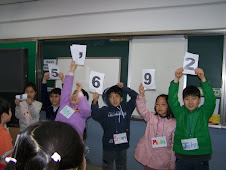Lesson Name: Dirty Salt
Grade Level/Subject: 4th Grade/Science
Type of Lesson: Experiment
Materials: Vocabulary Cards with English/Korean, mixture of salt and dirt, three beakers, water, stirrer, filter paper, funnel, clamp/stand, alcohol burner, dish, safety equipment (goggles and fire safe gloves)
Objectives:
1. Students will be able to use their prior knowledge to complete the separation experiment.
2. Students will be able to use a filtration process to separate dirt from a mixture of dirt, salt, and water.
3. Students will be able to use an evaporation process to separate salt from saltwater
Anticipatory Set:
· Tell the students that you have to tell them a horrible story. Continue by telling them the following story, “This morning my mother asked me to go to the market and buy some salt and then bring it to her when I come home from school. Well I bought the salt and I was going to be late for school so I was running and I tripped and fell and the bag of salt broke open and landed in a pile of soil. So I put the salt back in the bag, but now it has soil in it. I know my mother will not want to cook me any food with this salt, because we don’t eat soil. So what should I do? I need to find a way to get rid of the dirt so I can bring the salt to my mother after school today. Does anyone have any ideas?”
· Take responses from the students. Encourage them to think about the three previous experiments (the experiments involved separating mixtures such as soil and water or salt and water).
Actual Lesson:
Once the students realize that they have to use the skills they learned with the previous experiments help lead the students through this experiment. Don’t tell the students what to do next, have them come up with the ideas. As you move through the experiment put the new vocabulary words on the board in the correct order. Have the students repeat the English words at least three times.
Here is how the experiment should follow:
Add water to the mixture of salt and soil and stir to dissolve the salt. Ask the students what happens to the mixture when you added the water. Help them to understand that the soil sinks to the bottom of the mixture and the salt become dissolved in the water, so now they have a mixture of saltwater and dirt. Then introduce the new English vocabulary word: Dissolve.
Next, use the filter paper to filter the soil from the mixture. Create a cone with the filter paper and place it in the funnel with a beaker below to catch the saltwater. Allow time for the mixture to separate. Afterwards discuss with the students what happened to the saltwater and the soil. They should realize that the saltwater is now in the new beaker and the soil remains in the bottom of the old beaker and in the filter paper. Introduce the new English vocabulary word: Filtration
Now the students need to separate the salt from the water using an alcohol burner to evaporate the water. Have the students pour the saltwater into a dish and place the dish above the alcohol burner. It is at this time the students should put on their goggles and fireproof gloves. When they are ready, the teacher should go to each group and light their alcohol burner. Allow time for some of the water to evaporate. Ask the students if they can see any white stuff forming at the top of the dish. Help to realize that this is salt. Ask the students what is happening to the water. Where is it going? At this time introduce the new English vocabulary word: Evaporation. You will still need to allow time for all of the water to evaporate. Then discuss with the students what happened and explain that now we only have salt remaining in the dish.
Check for Understanding:
· What happens to the soil and salt when we add water to the mixture of soil and salt?
· How can we remove the soil from the saltwater and soil mixture?
· Where does the soil go when we filter the mixture?
· How can we separate the salt from the water?
· What happens to the water when we heat it up?
· What do we have remaining in the dish after all the water has evaporated?
Guided Practice:
The teacher helps lead the students through the experiment verbally and will provide physical assistance if needed.
Independent Practice:
The students provide the next steps in the experiment by using prior knowledge.
The students complete the steps of the experiment themselves, but may ask for assistance if needed.
Closing:
Review the new English vocabulary words. Have the students repeat after you at least three times.
Have the students lead you through the process of this experiment verbally using the new English vocabulary.
Tell the students you are so thankful because now you can take the salt home to your mother and you won’t have to eat soil.
Extended Practice:
Have the students recreate the experiment using pictures. The students can create a storyboard showing the steps in this separation experiment and can include the new English vocabulary.


No comments:
Post a Comment